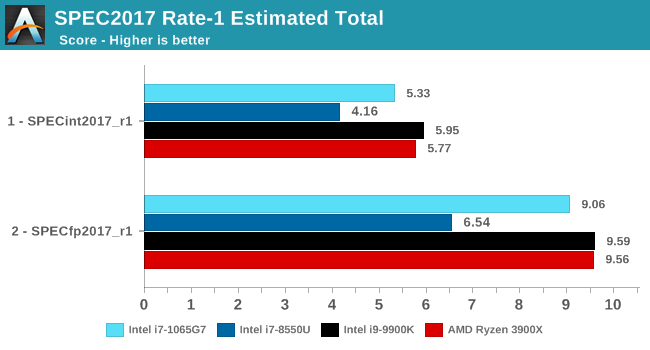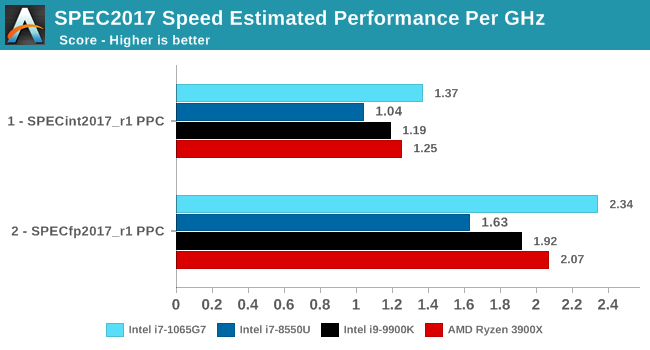The Ice Lake Benchmark Preview: Inside Intel's 10nm
by Dr. Ian Cutress on August 1, 2019 9:00 AM EST- Posted in
- CPUs
- Intel
- GPUs
- 10nm
- Core
- Ice Lake
- Cannon Lake
- Sunny Cove
- 10th Gen Core
Section by Andrei Frumusanu
SPEC2017 and SPEC2006 Results (15W)
SPEC2017 and SPEC2006 is a series of standardized tests used to probe the overall performance between different systems, different architectures, different microarchitectures, and setups. The code has to be compiled, and then the results can be submitted to an online database for comparsion. It covers a range of integer and floating point workloads, and can be very optimized for each CPU, so it is important to check how the benchmarks are being compiled and run.
We run the tests in a harness built through Windows Subsystem for Linux, developed by our own Andrei Frumusanu. WSL has some odd quirks, with one test not running due to a WSL fixed stack size, but for like-for-like testing is good enough. SPEC2006 is deprecated in favor of 2017, but remains an interesting comparison point in our data. Because our scores aren’t official submissions, as per SPEC guidelines we have to declare them as internal estimates from our part.
For compilers, we use LLVM both for C/C++ and Fortan tests, and for Fortran we’re using the Flang compiler. The rationale of using LLVM over GCC is better cross-platform comparisons to platforms that have only have LLVM support and future articles where we’ll investigate this aspect more. We’re not considering closed-sourced compilers such as MSVC or ICC.
clang version 8.0.0-svn350067-1~exp1+0~20181226174230.701~1.gbp6019f2 (trunk)
clang version 7.0.1 (ssh://git@github.com/flang-compiler/flang-driver.git
24bd54da5c41af04838bbe7b68f830840d47fc03)-Ofast -fomit-frame-pointer
-march=x86-64
-mtune=core-avx2
-mfma -mavx -mavx2
Our compiler flags are straightforward, with basic –Ofast and relevant ISA switches to allow for AVX2 instructions. Despite ICL supporting AVX-512, we have not currently implemented it, as it requires a much greater level of finesse with instruction packing. The best AVX-512 software uses hand-crafted intrinsics to provide the instructions, as per our 3PDM AVX-512 test later in the review.
For these comparisons, we will be picking out CPUs from across our dataset to provide context. Some of these might be higher power processors, it should be noted.
SPECint2006

Amongst SPECint2006, the one benchmark that really stands out beyond all the rest is the 473.astar. Here the new Sunny Cove core is showcasing some exceptional IPC gains, nearly doubling the performance over the 8550U even though it’s clocked 100MHz lower. The benchmark is extremely branch misprediction sensitive, and the only conclusion we can get to rationalise this increase is that the new branch predictors on Sunny Cove are doing an outstanding job and represent a massive improvement over Skylake.
456.hmmer and 464.h264ref are very execution bound and have the highest actual instructions per clock metrics in this suite. Here it’s very possible that Sunny Cove’s vastly increased out-of-order window is able to extract a lot more ILP out of the program and thus gain significant increases in IPC. It’s impressive that the 3.9GHz core here manages to match and outpace the 9900K’s 5GHz Skylake core.
Other benchmarks here which are limited by other µarch characteristics have various increases depending on the workload. Sunny Cove doubled L2 cache should certainly help with workloads like 403.gcc and others. However because we’re also memory latency limited on this platform the increases aren’t quite as large as we’d expect from a desktop variant of ICL.

In SPECfp2006, Sunny Cove’s wider out-of-order window can again be seen in tests such as 453.povray as the core is posting some impressive gains over the 8550U at similar clocks. 470.lbm is also instruction window as well as data store heavy – the core’s doubled store bandwidth here certainly helps it.

Overall in SPEC2006, the new i7-1065G7 beats a similarly clocked i7-8550U by a hefty 29% in the int suite and 34% in the fp suite. Of course this performance gap will be a lot smaller against 9th gen mobile H-parts at higher clocks, but these are also higher TDP products.
The 1065G7 comes quite close to the fastest desktop parts, however it’s likely it’ll need a desktop memory subsystem in order to catch up in total peak absolute performance.

Performance per clock increases on the new Sunny Cove architecture are outstandingly good. IPC increases against the mobile Skylake are 33 and 38% in the integer and fp suites, though we also have to keep in d mind these figures go beyond just the Sunny Cove architecture and also include improvements through the new LPDDR4X memory controllers.
Against a 9900K, although apples and oranges, we’re seeing 13% and 14% IPC increases. These figures likely would be higher on an eventual desktop Sunny Cove part.
SPEC2017



The SPEC2017 results look similar to the 2006 ones. Against the 8550U, we’re seeing grand performance uplifts, just shy of the best desktop processors.

Here the IPC increase also look extremely solid. In the SPECin2017 suite the Ice Lake part achieves a 14% increase over the 9900K, however we also see a very impressive 21% increase in the fp suite.
Overall in the 2017 suite, we’re seeing a 19% increase in IPC over the 9900K, which roughly matches Intel’s advertised metric of 18% IPC increase.










261 Comments
View All Comments
Alistair - Friday, August 2, 2019 - link
I find partisanship frustrating. You are absolutely right that we just got IPC but bad frequency from both AMD and Intel, so it is nice to see the IPC side of things, but we should be able to criticize Intel without someone brushing us off as being AMD supporters or some nonsense. The new products (these mobile chips in particular) are not very good. Still should be polite to Ian Cutress, he does do fantastic work.I guess I didn't get the memo that no 6 core ultra low voltage parts were coming. I'm very disappointed in the very tiny gains this year. I'm waiting for a good 6 core CPU at 25 watts.
0ldman79 - Friday, August 2, 2019 - link
Welcome to the Internet, where voicing an opinion on anything gets you labeled as a fanboy/X political party.Every good forum needs a block button... lol
eva02langley - Friday, August 2, 2019 - link
The difference here is that Ryzen 3000 clock higher than 2000.... little difference...Alistair - Friday, August 2, 2019 - link
Absolutely at least AMD's chips clock the same or an extra 100 mhz higher, Intel's new chips clock several hundred mhz slower, making them really poor this year. Making 6 core options more important than ever. 4 cores in this situation are really useless without a large price drop.0ldman79 - Friday, August 2, 2019 - link
This is also the efficient line of chips. Last I heard they got the efficient transistor design going but not the high performance one.They may clock higher, they may be limited by the architecture. Dunno. Could entirely be because they packed the chip too tight, the hotspots that spike the Zen 2 temps may actually be causing significant issues with 10nm. In this case the whole "transistors per sq mm" argument may become moot. Packing them in so tight they can't displace heat properly is a bad thing and may be what is happening here.
HStewart - Thursday, August 1, 2019 - link
I think you to give both Ian and Intel more credit, there is no doubt that Intel has some struggles with going to 10nm but this is first part of the recovery. The results here are extremely impressive especially that these products are low power laptop and not large desktop gaming machines.It would be interesting to compare the new Dell XPS 13 2in1 against existing dell XPS 15 2in1 in which the 15 2in1 has higher power cpu and GPU. I would say it likely with results here, the 13 2in1 has chance of beating the 15 2in1
It going to be interesting to see what 45W laptops are like and the desktop chips on Sunny Cove.
eva02langley - Friday, August 2, 2019 - link
Give Intel credit... HAHAHAHAHAHA.... they don't deserve any credit. These directors just want to have the stock rise to have a better pay check. Everything they do is biased with this in mind.unclevagz - Friday, August 2, 2019 - link
Public company senior management want stock price rises for bigger bonuses, in other news water is wet.Xyler94 - Sunday, August 4, 2019 - link
Water cannot be wet, funny enough. "Wet" is the property of an object that has come in contact with a liquid, most notibly water, since water cannot be I contact with itself to cause wetness, water is therefore, not wet. :PPhynaz - Friday, August 2, 2019 - link
Dumbass